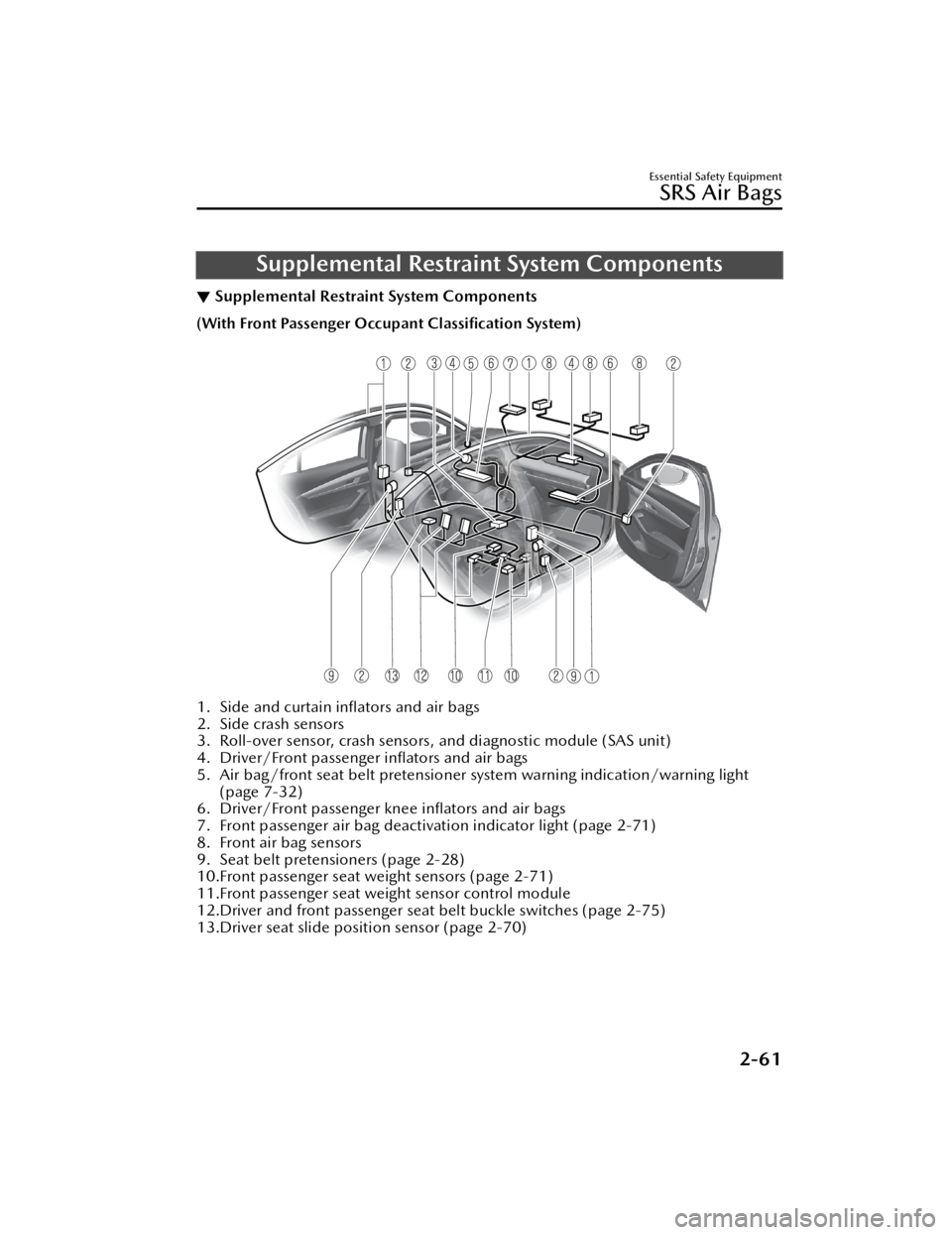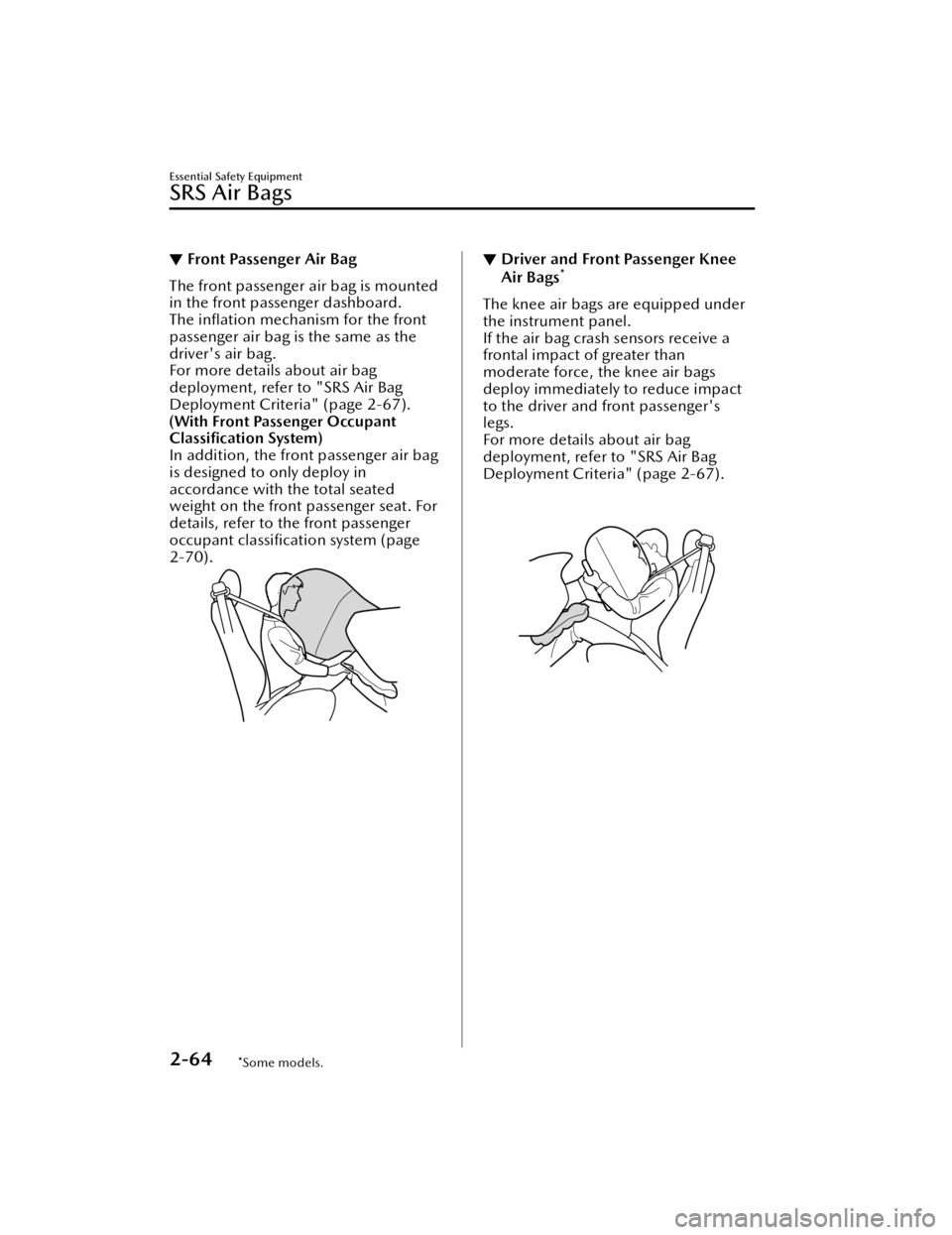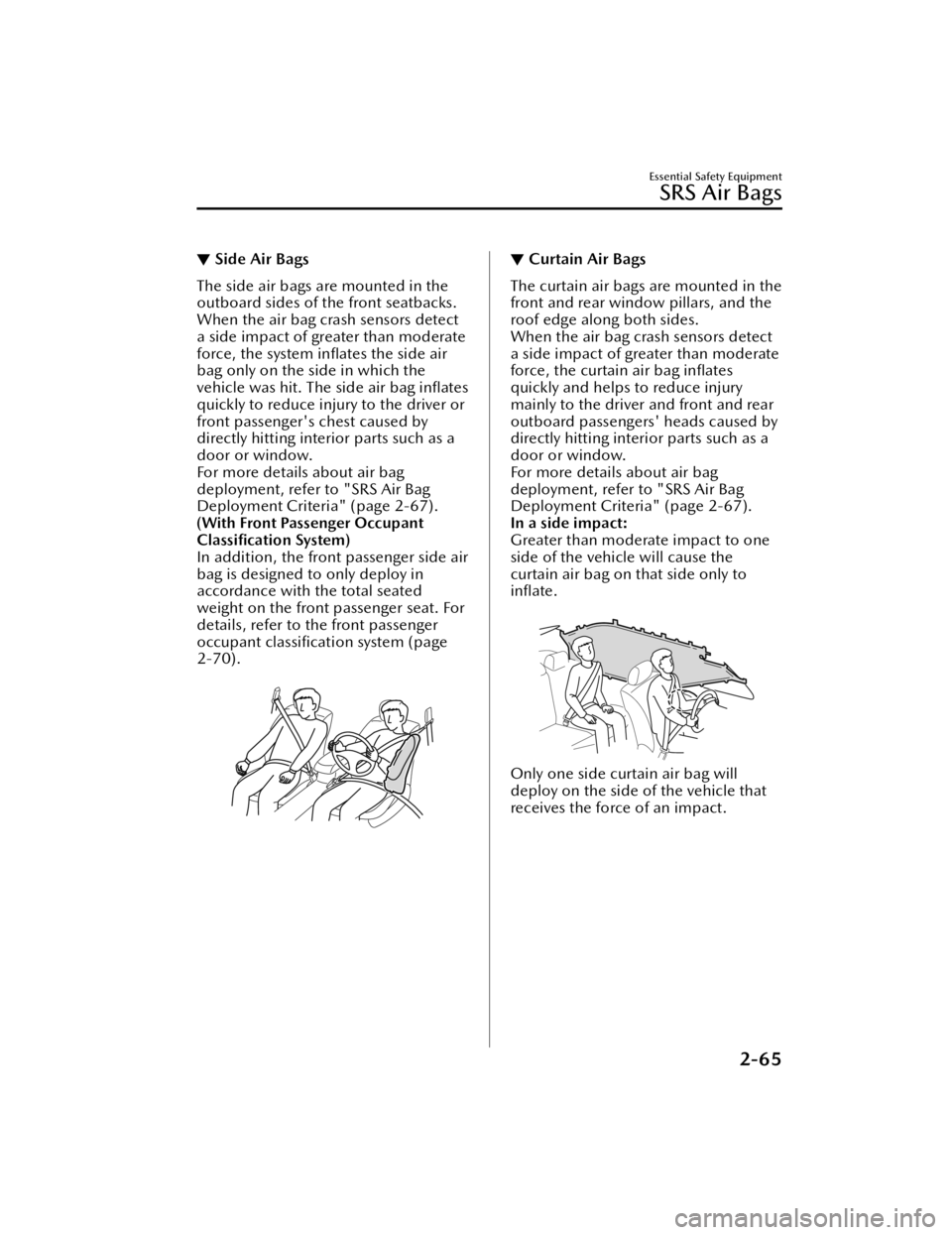sensor MAZDA MODEL 3 HATCHBACK 2021 User Guide
[x] Cancel search | Manufacturer: MAZDA, Model Year: 2021, Model line: MODEL 3 HATCHBACK, Model: MAZDA MODEL 3 HATCHBACK 2021Pages: 612, PDF Size: 89.06 MB
Page 72 of 612

Do not place any objects on the
assist grips. Only hang clothes
directly on the coat hooks.
Do not touch the components of the
supplemental restraint system after
the air bags have in flated:
Touching the components of the
supplemental restraint system after the
air bags have infl ated is dangerous.
Immediately after inflation, they are
very hot. You could get burned.
Never install any front-end equipment
to your vehicle:
Installation of front-end equipment,
such as frontal protection bar
(kangaroo bar, bull bar, push bar, or
other similar devices), snowplow, or
winches, is dangerous. The air bag
crash sensor system could be a ffected.
This could cause air bags to inflate
unexpectedly, or it could prevent the
air bags from inflating during an
accident. Front occupants could be
seriously injured.
Do not modify the suspension:
Modifying the vehi cle suspension is
dangerous. If the vehicle's height or
the suspension is modi fied, the vehicle
will be unable to accurately detect a
collision or roll-over accident resulting
in incorrect or unexpected air bag
deployment and the possibility of
serious injuries.To prevent false detection by the air
bag sensor system, heed the
following:
Do not use tires or wheels other than
those speci fied for your Mazda:
Use of any tire or wheel other than
those specified for your Mazda (page
9-10) is dangerous. Use of such
wheels will prevent the vehicle's
accident detections system from
accurately detecting a collision or
roll-over accident resulting in
incorrect or unexpected air bag
deployment and the possibility of
serious injuries.
Do not overload your vehicle:
Overloading your vehicle is
dangerous as it could prevent the air
bag crash sensor system from
accurately detecting a collision or
roll-over accident resulting in
incorrect or unexpected air bag
deployment and the possibility of
serious injuries. The gross axle
weight rating (GAWR) and the gross
vehicle weight rating (GVWR) for
your vehicle are on the Motor
Vehicle Safety Standard Label on the
driver's door frame. Do not exceed
these ratings.
Do not drive the vehicle o ff-road:
Driving your Mazda off-road is
dangerous because the vehicle has
not been designed to do so. Driving
the vehicle o ff-road could prevent
the air bag crash sensor system from
accurately detecting a collision or
roll-over accident resulting in
incorrect or unexpected air bag
deployment and the possibility of
serious injuries.
Essential Safety Equipment
SRS Air Bags
2-58
Mazda3_8JM2-EA -20H_Edition1_new 2020-7-10 17:21:34
Page 73 of 612

Do not modify a front door or leave
any damage unrepaired. Always have
an Authorized Mazda Dealer inspect a
damaged front door:
Modifying a front door or leaving any
damage unrepaired is dangerous. Each
front door has a side crash sensor as a
component of the supplemental
restraint system. If holes are drilled in a
front door, a door speaker is left
removed, or a damaged door is left
unrepaired, the sensor could be
adversely affected causing it to not
detect the pressure of an impact
correctly during a si de collision. If a
sensor does not detect a side impact
correctly, the side and curtain air bags
and the front seat belt pretensioner
may not operate norm ally which could
result in serious injury to occupants.
Do not modify the supplemental
restraint system:
Modifying the components or wiring of
the supplemental restraint system is
dangerous. You could accidentally
activate it or make it inoperable. Do
not make any modi fications to the
supplemental restraint system. This
includes installing trim, badges, or
anything else over the air bag modules.
It also includes installing extra
electrical equipment on or near system
components or wiring. An Authorized
Mazda Dealer can provide the special
care needed in the removal and
installation of front seats. It is
important to protect the air bag wiring
and connections to assure that the
bags do not accidentally deploy, and
that the front passenger occupant
classi fication system and the seats
retain an undamaged air bag
connection.Do not place luggage or other objects
under the front seats:
Placing luggage or other objects under
the front seats is dangerous. The
components essential to the
supplemental restraint system could be
damaged, and in the event of a side
collision, the appropriate air bags may
not deploy, which could result in death
or serious injury. To prevent damage to
the components essential to the
supplemental restraint system, do not
place luggage or other objects under
the front seats.
Do not operate a vehicle with
damaged air bag/seat belt
pretensioner system components:
Expended or damaged air bag/seat
belt pretensioner system components
must be replaced after any collision
which caused them to deploy or
damage them. Only a trained
Authorized Mazda Dealer can fully
evaluate these systems to see that they
will work in any subsequent accident.
Driving with an expended or damaged
air bag or pretensioner unit will not
a ff ord you the necessary protection in
the event of any subsequent accident
which could result in serious injury or
death.
Do not remove interior air bag parts:
Removing any components such as the
front seats, front dashboard, the
steering wheel or pa rts on the front
and rear window pillars and along the
roof edge, containing air bag parts or
sensors is dangerous. These parts
contain essential air bag components.
The air bag could accidentally activate
and cause serious injuries. Always have
an Authorized Mazda Dealer remove
these parts.
Essential Safety Equipment
SRS Air Bags
2-59
Mazda3_8JM2-EA -20H_Edition1_new 2020-7-10 17:21:34
Page 75 of 612

Supplemental Restraint System Components
▼Supplemental Restraint System Components
(With Front Passenger Occupant Classifi
cation System)
1. Side and curtain inflators and air bags
2. Side crash sensors
3. Roll-over sensor, crash sensors, and diagnostic module (SAS unit)
4. Driver/Front passenger in flators and air bags
5. Air bag/front seat belt pretensioner system warning indication/warning light (page 7-32)
6. Driver/Front passenger knee in flators and air bags
7. Front passenger air bag deactivation indicator light (page 2-71)
8. Front air bag sensors
9. Seat belt pretensioners (page 2-28)
10.Front passenger seat we ight sensors (page 2-71)
11.Front passenger seat weight sensor control module
12.Driver and front passenger seat belt buckle switches (page 2-75)
13.Driver seat slide position sensor (page 2-70)
Essential Safety Equipment
SRS Air Bags
2-61
Mazda3_8JM2-EA -20H_Edition1_new 2020-7-10 17:21:34
Page 76 of 612

(Without Front Passenger Occupant Classification System)
1. Side and curtain inflators and air bags
2. Side crash sensors
3. Driver/Front passenger in flators and air bags
4. Air bag/ front seat belt pretensioner system warning indication
/warning light (page 7-32)
5. Driver knee in flator and air bag
6. Front air bag sensor
7. Seat belt pretensioners (page 2-28)
8. Crash sensors, and diagnostic module (SAS unit)
Essential Safety Equipment
SRS Air Bags
2-62
Mazda3_8JM2-EA -20H_Edition1_new 2020-7-10 17:21:34
Page 77 of 612

How the SRS Air BagsWork
▼How the SRS Air Bags Work
Your Mazda is equipped with the
following types of SRS air bags. SRS air
bags are designed to work together
with the seat belts to help to reduce
injuries during an accident.
The SRS air bags are designed to
provide further protection for
passengers in addition to the seat belt
functions. Be sure to wear seat belts
properly.
▼Front Seat Belt Pretensioners
The front seat belt pretensioners are
designed to deploy in moderate or
severe frontal, near frontal collisions.
In addition, the pretensioners operate
when a side collision or a roll-over
accident is detected. The pretensioners
operate
differently depending on what
types of air bags are equipped. For
more details about seat belt
pretensioner operation, refer to the
SRS Air Bag Deployment Criteria (page
2-67).
▼ Driver Air Bag
The driver's air bag is mounted in the
steering wheel.
When air bag crash sensors detect a
frontal impact of greater than
moderate force, the driver's air bag
in
flates quickly helping to reduce injury
mainly to the driver's head or chest
caused by directly hitting the steering
wheel.
For more details about air bag
deployment, refer to "SRS Air Bag
Deployment Criteria" (page 2-67).
(With Front Passenger Occupant
Classi fication System)
The driver's dual-stage air bag controls
air bag in flation in two energy stages.
During an impact of moderate severity,
the driver's air bag deploys with lesser
energy, whereas during more severe
impacts, it deploys with more energy.
Essential Safety Equipment
SRS Air Bags
2-63
Mazda3_8JM2-EA -20H_Edition1_new 2020-7-10 17:21:34
Page 78 of 612

▼Front Passenger Air Bag
The front passenger air bag is mounted
in the front passenger dashboard.
The infl
ation mechanism for the front
passenger air bag is the same as the
driver's air bag.
For more details about air bag
deployment, refer to "SRS Air Bag
Deployment Criteria" (page 2-67).
(With Front Passenger Occupant
Classi fication System)
In addition, the front passenger air bag
is designed to only deploy in
accordance with the total seated
weight on the front passenger seat. For
details, refer to the front passenger
occupant classification system (page
2-70).
▼ Driver and Front Passenger Knee
Air Bags*
The knee air bags are equipped under
the instrument panel.
If the air bag crash sensors receive a
frontal impact of greater than
moderate force, the knee air bags
deploy immediately to reduce impact
to the driver and front passenger's
legs.
For more details about air bag
deployment, refer to "SRS Air Bag
Deployment Criteria" (page 2-67).
Essential Safety Equipment
SRS Air Bags
2-64*Some models.
Mazda3_8JM2-EA
-20H_Edition1_new 2020-7-10 17:21:34
Page 79 of 612

▼Side Air Bags
The side air bags are mounted in the
outboard sides of the front seatbacks.
When the air bag crash sensors detect
a side impact of greater than moderate
force, the system in
flates the side air
bag only on the side in which the
vehicle was hit. The side air bag in flates
quickly to reduce injury to the driver or
front passenger's chest caused by
directly hitting interior parts such as a
door or window.
For more details about air bag
deployment, refer to "SRS Air Bag
Deployment Criteria" (page 2-67).
(With Front Passenger Occupant
Classi fication System)
In addition, the front passenger side air
bag is designed to only deploy in
accordance with the total seated
weight on the front passenger seat. For
details, refer to the front passenger
occupant classi fication system (page
2-70).
▼ Curtain Air Bags
The curtain air bags are mounted in the
front and rear window pillars, and the
roof edge along both sides.
When the air bag crash sensors detect
a side impact of greater than moderate
force, the curtain air bag in
flates
quickly and helps to reduce injury
mainly to the driver and front and rear
outboard passengers' heads caused by
directly hitting interior parts such as a
door or window.
For more details about air bag
deployment, refer to "SRS Air Bag
Deployment Criteria" (page 2-67).
In a side impact:
Greater than moderate impact to one
side of the vehicle will cause the
curtain air bag on that side only to
in flate.
Only one side curtain air bag will
deploy on the side of the vehicle that
receives the force of an impact.
Essential Safety Equipment
SRS Air Bags
2-65
Mazda3_8JM2-EA -20H_Edition1_new 2020-7-10 17:21:34
Page 84 of 612

Limitations to roll-over detection
(With Front Passenger Occupant
Classification System):
The following illustration is an example
of an accident that may not be
detected as a roll-over accident.
Therefore, the front seat belt
pretensioners and curtain air bags may
not deploy.
Pitch end over end
Driver and Front
Pa s s e n g e r O cc u p a n t
Classi fication System
*
▼ Driver and Front Passenger
Occupant Classi
fication System
First, please read "Supplemental
Restraint System (SRS) Precautions"
(page 2-55) carefully.
▼ Driver Seat Slide Position Sensor
Your vehicle is equipped with a driver
seat slide position sensor as a part of
the supplemental restraint system. The
sensor is located under the driver seat.
The sensor determines whether the
driver seat is fore or aft of a reference
position and sends the seat position to
the diagnostic module (SAS unit).
The SAS unit is designed to control the
deployment of the driver air bag
depending on how close the driver
seat is to the steering wheel.
The air bag/front seat belt
pretensioner system warning light
fl
ashes if the sensor has a possible
malfunction (page 2-66).
Essential Safety Equipment
SRS Air Bags
2-70*Some models.
Mazda3_8JM2-EA -20H_Edition1_new 2020-7-10 17:21:34
Page 85 of 612

▼Front Passenger Seat Weight
Sensors
Your vehicle is equipped with a front
passenger seat weight sensors as a part
of the supplemental restraint system.
These sensors are located under both
of the front passenger seat rails. These
sensors determine the total seated
weight on the front passenger seat and
monitor the seat belt buckle for the
front passenger seat. The SAS unit is
designed to prevent the front
passenger front and side air bags and
knee air bags, and seat belt
pretensioner system from deploying if
the front passenger air bag
deactivation indicator light illuminates.
To reduce the chance of injuries
caused by deployment of the front
passenger air bag, the system
deactivates the front passenger front
and side air bags and knee air bags,
and also the seat belt pretensioner
system when the front passenger air
bag deactivation indicator light
illuminates. Refer to the following
table for the front passenger air bag
deactivation indicator light
illumination conditions.
This system shuts o
ff the front
passenger front and side air bags and
knee air bags, and seat belt
pretensioner system, so make sure the
front passenger air bag deactivation
indicator light illuminates according to
the following table.
The air bag/front seat belt
pretensioner system warning light
fl ashes and the front passenger air bag
deactivation indicator light illuminates
if the sensors have a possible
malfunction. If this happens, the front
passenger front and side air bags and
knee air bags, and seat belt
pretensioner system will not deploy.
Front passenger air bag deactivation
indicator light
This indicator light illuminates to
remind you that the front passenger
front and side air bags and knee air
bags, and seat belt pretensioners will
not deploy during a collision.
Essential Safety Equipment
SRS Air Bags
2-71
Mazda3_8JM2-EA -20H_Edition1_new 2020-7-10 17:21:34
Page 86 of 612

If the front passenger weight sensors
are normal, the indicator light
illuminates when the ignition is
switched ON. The light turns off after a
few seconds. Then, the indicator light
illuminates or is o ff under the following
conditions:
Front passenger air bag deactivation
indicator light on/off condition chart
Condition
detected by the
front pas-
senger oc- cupant
classifi ca-
tion sys- tem Front pas-
senger air
bag deacti-
vation indi- cator light Front pas-
senger
front and side andknee air
bags Front
passen-
ger seat
belt pre-
tensioner
system
Empty
(Not occu-
pied) On
Deactivat-
ed Deacti-
vated
Child or
child-re-
straint sys-
tem
*1
On Deactivat-
ed Deacti-
vated
Adult
*2Off Ready Ready
*1 If a larger child sits on the front passenger
seat, the sensors might detect the child as
being an adult depending on the child's
physique.
*2 If a smaller adult sits on the front passengerseat, the sensors might detect the person as
being a child depending on the person's
physique.
The curtain air bag is ready for in flating
regardless of what the front passenger air bag
deactivation indicator light on/o ff condition
chart indicates.
If the front passenger air bag
deactivation indicator light does not
illuminate when the ignition is
switched ON and does not illuminate
as indicated in the front passenger air
bag deactivation indicator light on/o ff
condition chart, do not allow a child to
sit in the front passenger seat and
consult an Authorized Mazda Dealer
as soon as possible. The system may
not work properly in an accident.
WARNING
Do not decrease the total seated
weight on the front passenger seat:
When an adult or large child sits on the
front passenger seat, decreasing the
total seated weight on the front
passenger seat required for air bag
deployment is dangerous. The front
passenger seat weight sensors will
detect the reduced total seated weight
condition and the front passenger front
and side air bags and knee air bags,
and the seat belt pretensioner system
will not deploy during an accident. The
front passenger will not have the
supplementary protection of the air
bag, which could result in serious
injury. Decreasing the total seated
weight on the front passenger seat
could result in an air bag not deploying
under the following conditions, for
example:
Essential Safety Equipment
SRS Air Bags
2-72
Mazda3_8JM2-EA -20H_Edition1_new 2020-7-10 17:21:34